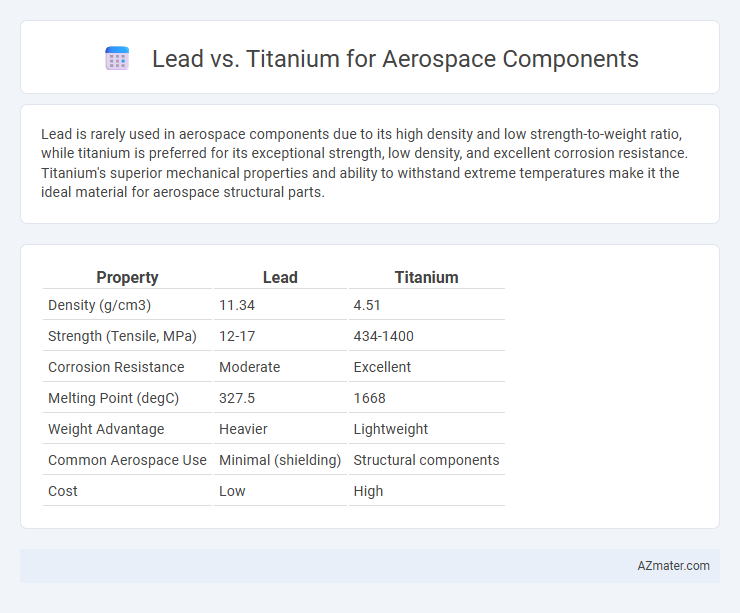Lead is rarely used in aerospace components due to its high density and low strength-to-weight ratio, while titanium is preferred for its exceptional strength, low density, and excellent corrosion resistance. Titanium's superior mechanical properties and ability to withstand extreme temperatures make it the ideal material for aerospace structural parts.
Table of Comparison
| Property | Lead | Titanium |
|---|---|---|
| Density (g/cm3) | 11.34 | 4.51 |
| Strength (Tensile, MPa) | 12-17 | 434-1400 |
| Corrosion Resistance | Moderate | Excellent |
| Melting Point (degC) | 327.5 | 1668 |
| Weight Advantage | Heavier | Lightweight |
| Common Aerospace Use | Minimal (shielding) | Structural components |
| Cost | Low | High |
Introduction to Lead and Titanium in Aerospace
Lead and titanium serve distinct roles in aerospace engineering due to their contrasting properties; lead is primarily used for radiation shielding and vibration damping, while titanium is favored for structural components owing to its high strength-to-weight ratio and corrosion resistance. Titanium alloys, such as Ti-6Al-4V, dominate aerospace manufacturing for critical airframe and engine parts, offering exceptional durability under extreme temperatures and mechanical stress. Lead's density provides effective protection in avionics and cockpit areas, contributing to crew safety in environments with high radiation exposure.
Material Properties: Lead vs Titanium
Titanium exhibits a superior strength-to-weight ratio and exceptional corrosion resistance, making it ideal for aerospace components requiring high durability and lightweight performance. Lead, with its high density and excellent vibration damping, is less suitable due to its low tensile strength and poor structural integrity. The critical advantage of titanium lies in its capacity to withstand extreme temperatures and mechanical stresses without deformation, essential for aerospace applications.
Weight Comparison: Impact on Aerospace Design
Titanium offers a significant weight advantage over lead, with a density of approximately 4.5 g/cm3 compared to lead's 11.34 g/cm3, making it far more suitable for aerospace components where reducing weight is crucial. Lighter titanium components improve fuel efficiency and overall aircraft performance by minimizing structural mass without sacrificing strength or durability. The weight reduction afforded by titanium directly correlates with enhanced payload capacity and extended flight range in aerospace design.
Strength, Durability, and Fatigue Resistance
Titanium exhibits superior strength-to-weight ratio compared to lead, making it ideal for aerospace components requiring high structural integrity with minimal mass. Its exceptional durability resists corrosion and environmental degradation, ensuring prolonged performance under extreme conditions. Titanium also offers outstanding fatigue resistance, crucial for withstanding the cyclic stresses experienced during flight, whereas lead's low strength and poor fatigue characteristics limit its aerospace applicability.
Corrosion Resistance and Longevity
Titanium alloys exhibit superior corrosion resistance compared to lead, making them ideal for aerospace components exposed to harsh environments and extreme temperatures. While lead offers some resistance to corrosion, its softness and susceptibility to oxidation limit its longevity in aerospace applications. Titanium's high strength-to-weight ratio and ability to maintain structural integrity under stress ensure extended service life and reduced maintenance for critical aerospace parts.
Thermal Conductivity and Performance
Titanium exhibits superior thermal conductivity and high strength-to-weight ratio, making it ideal for aerospace components requiring efficient heat dissipation and structural performance. Lead, with lower thermal conductivity and much higher density, is rarely used in aerospace due to its weight and limited thermal management capabilities. Titanium alloys outperform lead by maintaining mechanical integrity under extreme temperature variations, ensuring durability and reliability in aerospace applications.
Machinability and Manufacturing Considerations
Titanium offers superior strength-to-weight ratio and corrosion resistance compared to lead, making it the preferred material for aerospace components despite its challenging machinability, which requires specialized tooling and slower cutting speeds. Lead's excellent machinability due to its softness and low melting point makes it easier to machine, but its heavy weight and toxicity disqualify it from critical aerospace applications. Manufacturing titanium components demands advanced techniques such as precision CNC machining and grinding, ensuring durability and performance critical for aerospace standards.
Safety, Toxicity, and Environmental Impact
Titanium's superior corrosion resistance and high strength-to-weight ratio make it a safer choice than lead for aerospace components, minimizing structural failures. Lead's toxicity poses significant health risks to workers and challenges in safe disposal, whereas titanium is biocompatible and non-toxic. Environmentally, titanium's recyclability and lower ecological footprint contrast sharply with lead's persistent pollution and contamination concerns.
Cost Analysis: Lead vs Titanium Components
Lead components in aerospace applications offer a lower initial material cost compared to titanium but suffer from higher weight and lower strength-to-weight ratios, increasing fuel consumption and overall operational expenses. Titanium's superior corrosion resistance, high strength, and lightweight properties result in longer component lifespan and reduced maintenance costs, offsetting its higher upfront price. When conducting a cost analysis, the total lifecycle cost favors titanium due to improved fuel efficiency and durability despite its premium procurement cost.
Applications and Suitability in Aerospace Industry
Titanium's high strength-to-weight ratio, corrosion resistance, and ability to withstand extreme temperatures make it ideal for aerospace components such as airframes, engine parts, and fasteners. Lead, due to its high density and radiation shielding properties, is mainly used in aerospace for specialized applications like radiation shielding in avionics and space vehicles rather than structural components. The aerospace industry's emphasis on weight reduction and durability prioritizes titanium over lead for most critical structural applications.

Infographic: Lead vs Titanium for Aerospace Component
 azmater.com
azmater.com